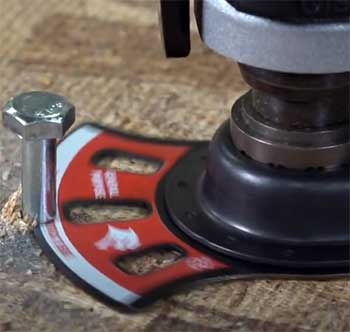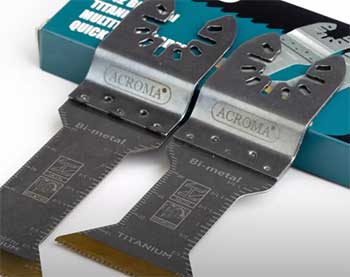Do you plan to buy oscillating blades for your next woodworking projects?
In that case, you will have to decide to choose the blade type. Choosing carbide or oscillating titanium blades is always challenging for a regular user. The hardness of the blades has to be the main difference between the two blade choices.
Other than that, several other differences and factors differentiate these two choices. Once you go through the details of the two options, you will get an idea of which one is more suitable for you and which one you should pick.
So, let’s not make it lengthy and jump right into the discussion.
A Quick Comparison Table
| Specifications | Tungsten Carbide Blades | Titanium Blades |
| Hardness | 84 HRC | 36 HRC |
| Weight | Heavier | Lighter |
| Compatible with | Stainless steel, Nails and bolts, fiberglass, Hardened Screws | Aluminum, Copper, Plastic, Wood, brass |
| Not the best for | Wood surfaces | Heavy-duty steel or metal |
Key Differences Between Carbide And Titanium Oscillating Blades
- Hardness

The most noticeable difference you get to experience with the two kinds of oscillating blades is in their hardness.
It is because both of them have a different hardness rating on them.
The hardness may help you decide on one of the choices based on your project requirements.
Coming in first is the hardness of Tungsten carbide. It has an HRC of 84 from the Rockwell C scale measuring hardness.
Because of that, you end up with excellent hardness in the carbide oscillating blades.
This factor makes it suitable for projects that require you to use a pretty strong and hardy blade for cutting.
Comparing that to the Titanium oscillating blades, you have an HRC rating of 36. So, you can see how drastic the difference is between the two choices just from the rating.
Due to this reason, you can’t use an oscillating titanium blade for projects that require excellent hardness from it.
Considering the two choices and their hardness rating, I would say Tungsten carbide is the clear pick for heavier projects. Especially when you have to cut through other heavy-duty metal, carbide is the perfect pick for you.
Other than that, you can go with Titanium blades.
- Weight
Well, typically, weight doesn’t impact the results or performance of the blades that much. Still, it can be an issue with the comfort of using the oscillating blades. Or it can affect the maneuverability of the blades too.
Starting with the Tungsten carbide oscillating blades, I have to say they are a bit on the heavier side. I mean, Tungsten carbide is a bit heavier than titanium. So, it’s only evident that they will also be heavier with their oscillating blades.
Since Titanium oscillating blades are lighter in comparison, you have better controllability with these blades. You can move around the blades without trouble, which may help you cut the corners of smaller items.
This factor means that Tungsten carbide is a better pick when you have to work on a larger project or heavier material. Because of the heavy weight, you will get an advantage in cutting through the material.
With Titanium blades, smaller projects or materials are better because you won’t cause any damage.
- Compatible Materials
Many things get more manageable when you consider the compatibility factor of the two oscillating blades. The two types of oscillating blades are compatible with a variety of materials.

Therefore, you can choose suitable oscillating blades based on the materials you will be using.
When you go through the compatible materials of Tungsten carbide oscillating blades, you will find most metals here.
For example, you can use the blade to cut through stainless steel, fiberglass, hardened screws, nails, and bolts.
So you won’t have to worry about cutting through hard materials.
As with the Titanium oscillating blades, you can’t cut through such heavy materials. However, this blade is suitable for cutting through wood, brass, copper, plastic, and aluminum.
- Not The Best For
The previous factor was more about using which type of oscillating blades. Here, it’s more about where you should avoid these project choices.
Keeping it simple, in wooden projects, never use the oscillating carbide blades. They can be a bit overpowering and damage the wooden pieces for your projects.
So, avoid using the tungsten carbide oscillating blades on your wooden projects.
On the contrary, never use oscillating titanium blades when dealing with heavy-duty metals. They don’t have that kind of hardness to cut through these metals.
As a result, you end up damaging the blades. In addition, you can’t use the blades later on, even if you want to.
Which One Is A Better Pick For You?
I would say the decision always boils down to the purpose of your oscillating blades. For example, if you want oscillating blades to cut through some heavy materials, pick the Carbide oscillating blades.
But pick titanium oscillating blades if your purpose is cutting through simple materials like wood or plastic. Because using too many powerful blades there, can go the opposite way and start damaging the material more than you would like it.
Here are my favorite titanium oscillating blades.
Frequently Asked Questions (FAQ)
You can’t choose one blade and call it the best, as they serve different purposes. But usually, you will see saw blades are a bit better than other types of blades.
Carbide is much better than titanium when it comes to cutting metal.
Carbide blades are great for cutting through metal and heavy-duty materials like fiberglass, nuts, and bolts.
You can use a carbide blade for a multi-tool to get jobs like concrete, grout, plaster, etc.
Conclusion
To conclude, in carbide vs. oscillating titanium blades, you think about the purpose and project for which you want to use the blades. For cutting heavy materials like metal, go with the carbide, specifically, tungsten carbide oscillating blade.
But if your projects involve light or regular materials, go with oscillating titanium blades, as they suit your needs even better.

Quick, clean, evaluation of carbide/ Ti blades, Thanks, saved me $$$$.
Thanks for clarifying this. I was totally uninformed until your page. I found it through a Google search. Unfortunately now it looks like I’ll have to buy a set of each blade type! Since I’ll probably forget I’ll probably have to put a little note like “carbide for hard & metal, titanium for soft” in my blade box.
Perfect, just the information I needed.